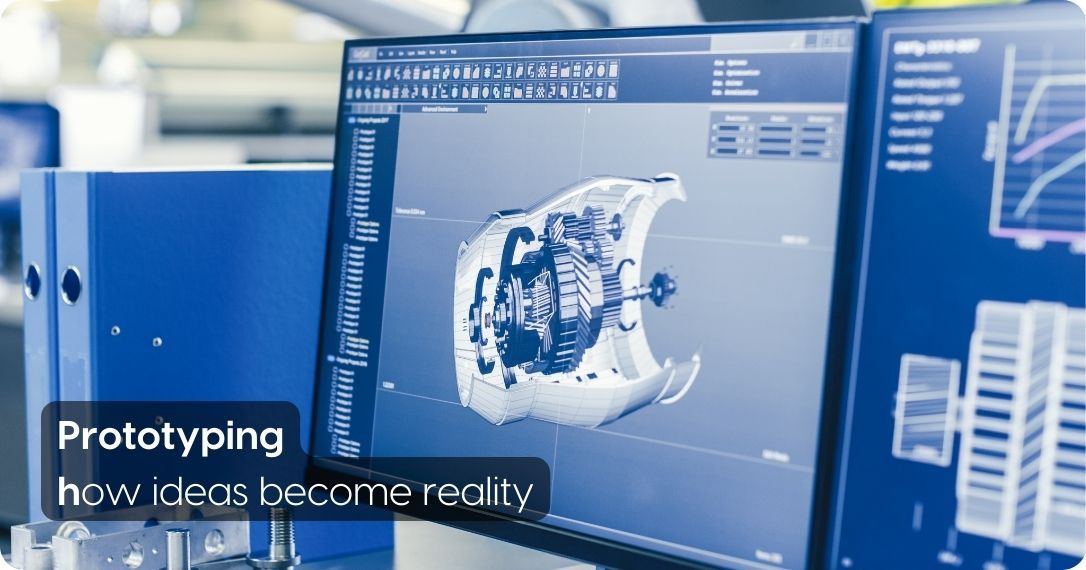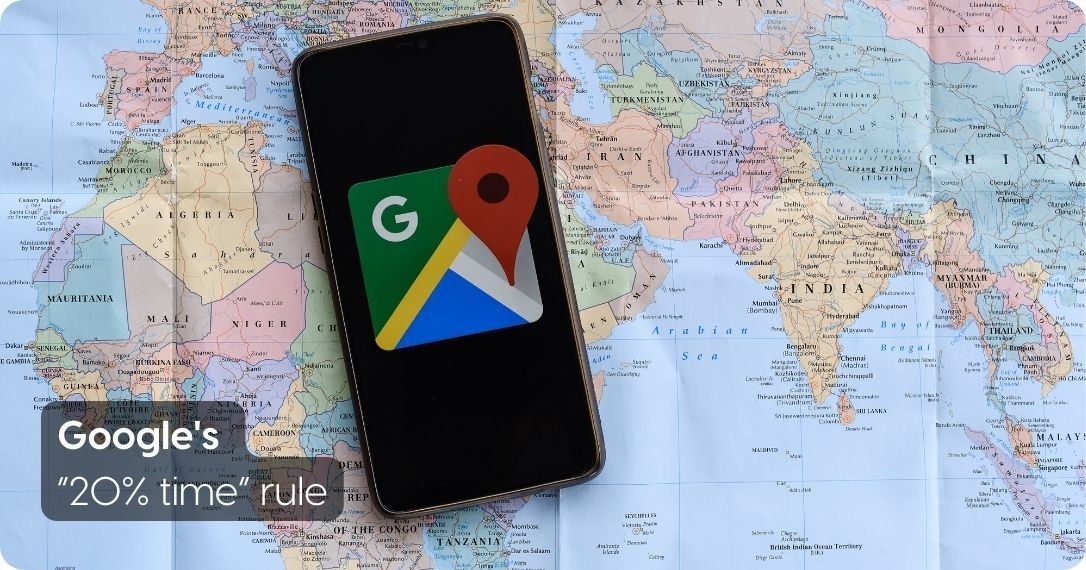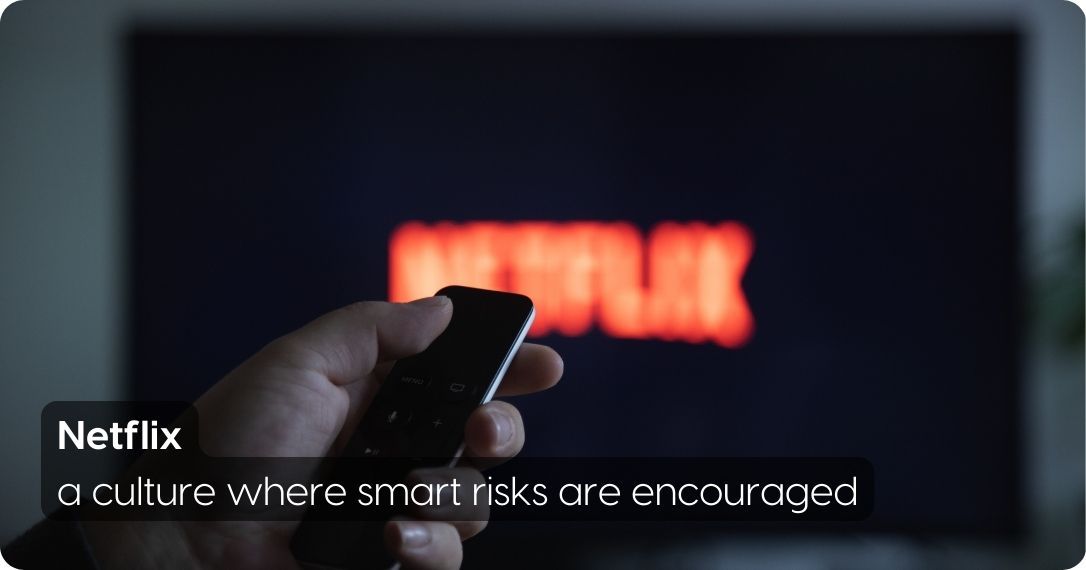Business Innovation: What It Actually Means

14 April, 2025
Share this article
Table of Contents
Remember when brainstorming meant staring at a blank page for hours, hoping inspiration would strike? And some days, nothing came because… well, your brain just wasn’t in the mood?
Now there are AIs that can throw out five solid ideas before you’ve even had coffee. That shift didn’t happen ten years ago, it happened in the last two. That’s how fast things are moving.
Business innovation is about doing things in new and better ways. It could mean improving a product, fixing something that’s clearly outdated, or changing how a company works.
Sometimes it’s small. Sometimes it’s about shaking up an entire industry. Yes, even disrupting the market—for real, not just for the buzzword bingo.
Things move fast. What worked yesterday might be irrelevant tomorrow. Customers expect more, technology doesn’t sit still, and new players can pop up out of nowhere. If you’re not adapting, you’re falling behind.
Look at Netflix—they went from mailing DVDs to rewriting how we consume entertainment. That wasn’t just adaptation. That was leading the change.
Innovation is how businesses stay in the game. It keeps them competitive, helps them grow, and opens up new opportunities. Sometimes it’s a bold, public move. Other times, it’s behind-the-scenes stuff that makes everything run smoother.
And no, innovation isn’t reserved for flashy tech companies. Any business can do it. It starts with mindset: being open to ideas, willing to try, and not afraid to break the routine. Or the rules, occasionally.
Understanding Business Innovation
Business innovation isn’t just about big, flashy ideas. It’s about doing things better—helping a company grow, stay flexible, and not get left behind. Sometimes it’s a huge shift that changes everything. Other times, it’s a small improvement that just makes things run smoother.
Take smartphones. Apple didn’t invent the phone—but when the iPhone came out, it completely changed how we use tech. That’s what we call disruptive innovation: it flips the script and shakes up the whole market. But Apple doesn’t launch a revolution every year.
Most iPhone updates are smaller changes—better cameras, faster chips, slightly longer battery life. That’s incremental innovation: the steady upgrades that keep a product relevant.

Both types matter. Disruptive innovation creates big opportunities. Incremental innovation keeps things moving forward. Companies like Tesla, Amazon, or Airbnb made waves by doing things differently—but even a small business can innovate.
Maybe it’s streamlining how you work, improving customer service, or finally ditching that terrible software everyone hates.
At the end of the day, innovation is about being ready for change. Because change is constant. And the businesses that keep adapting are the ones that stick around.
Types of Business Innovation
Innovation isn’t one-size-fits-all. It comes in different shapes, depending on what a company wants to improve—or shake up completely. Some focus on building better products. Others change how they work. And a few go all in and reinvent the whole game. Here are the main types of business innovation, explained without the jargon:
1. Product Innovation
This one’s the most obvious: making better stuff. It could mean launching something completely new or improving what you already sell. Think smartphones—every year they get faster, smarter, and take even more flattering selfies.
Or look at Tesla: they didn’t just tweak existing cars, they got people to rethink what a car can be. Product innovation helps you stay in the race—and ideally, a few steps ahead.
2. Process Innovation
This is less visible, but just as important. It’s about how things get done behind the scenes—making operations smoother, cheaper, faster. Like Amazon using robots in their warehouses to speed up deliveries. Or manufacturers using AI to catch defects before they become expensive problems. It’s not flashy, but it can save time, money, and a lot of headaches.
3. Business Model Innovation
Sometimes the product stays the same, but the way you deliver it changes everything. Remember when Netflix used to send DVDs by mail? Now it’s all about streaming.
Or how Airbnb lets people book homes without hotels being involved at all. That’s business model innovation—changing how value gets to the customer. Done right, it can flip an industry on its head.
4. Disruptive Innovation
This is the big one—the “whoa, everything’s different now” kind of innovation. It doesn’t just improve something, it rewrites the rules. Uber and Lyft did that to taxis. Digital cameras did it to film.
Smartphones pretty much swallowed half the electronics market. Disruptive innovation creates entirely new markets and makes old ways obsolete.

The Role of Idea Generation, Development and Implementation
Innovation usually starts with a simple question: Can we do this better? Sometimes the answer leads to something small. Sometimes it changes everything. But it always takes more than just a good idea. You need a plan, a team, and a lot of follow-through.
Where New Ideas Come From
Ideas can come from anywhere—if you’re paying attention. Companies that encourage curiosity and give people room to try things are usually the ones that come up with better ways of doing business. Here’s where most ideas start:
- Customer feedback. If people keep asking for the same thing or complaining about the same issue, it’s probably worth looking into.
- Market research. Trends, competitors, gaps in the market—keeping an eye on what’s happening helps you stay ahead.
- Brainstorming sessions. Sometimes a casual team chat can unlock something no one thought of alone.
- Hackathons and innovation labs. Set aside time for people to experiment, and they’ll often come up with surprisingly good stuff.
How Ideas Become Reality
Coming up with an idea is just step one. Making it real takes effort, testing, and probably a few course corrections. Most companies follow a basic process like this:
1. Idea generation – Spot a problem or opportunity and throw out possible solutions.
2. Concept development – Pick the most promising idea and figure out if it actually works.
3. Prototyping – Build a simple version to see if it holds up in practice.

4. Testing and feedback – Let real users try it and pay attention to what they say.
5. Implementation – Put it into the real world, either for customers or internal teams.
6. Iteration – Improve based on what works, what doesn’t, and what you’ve learned.
It’s not always smooth. But if you’re open to trying, failing, adjusting, and trying again, you’re already doing the hard part.
The Importance of Testing and Iteration
Most ideas don’t work perfectly right away. And that’s totally normal. That’s why testing and making changes along the way is such a big part of innovation. You try something, see what works (and what doesn’t), then improve it.
Even big names like Airbnb or Instagram didn’t get it right on the first try. They started with different ideas and shifted direction based on feedback, timing, and a bit of trial and error.
Innovation isn’t a one-time thing—it’s a process. The companies that keep testing, learning, and improving are the ones that stay ahead. Whether it’s a small tweak that saves time or a bold new idea that changes everything, what matters is staying curious and never getting too comfortable.

How Innovation Drives Growth and Competitive Advantage
Innovation isn’t just a trendy word people throw around. It’s what separates the businesses that grow from the ones that get left behind.
Companies that keep innovating don’t just keep up—they often lead the way. Maybe it’s a product no one saw coming, a smarter way of working, or a totally new business model.
However it shows up, innovation helps businesses grow, stay relevant, and outpace the competition.
It’s not about being the loudest. It’s about being the smartest at adapting, evolving, and building something that actually works better.
Case Studies of Successful Business Innovations
Some of the most successful companies didn’t get there by playing it safe. They took risks, tried new things, and challenged how their industries worked. Here are a few examples of what real innovation looks like:
• Tesla
Before Tesla, electric cars had a bad reputation—slow, expensive, not practical. Tesla flipped the script. They built fast, stylish EVs with long battery life and made people actually want them. They also skipped the usual car dealerships and sold directly to customers. Now Tesla’s not just about cars—it’s part of a much bigger push for clean energy.
• Apple
Apple’s known for sleek devices, but their real magic is how everything works together. The iPhone wasn’t just a better phone—it was the start of an entire ecosystem: the App Store, iCloud, Apple Pay, and more. They’ve kept raising the bar by combining hardware, software, and services into something that just works.
• Amazon
Amazon began as an online bookstore, but it didn’t stop there. One-click shopping, fast delivery, Alexa, smart devices—you name it, they’ve probably done it. And let’s not forget AWS. That move into cloud computing turned Amazon into a tech powerhouse way beyond retail.

How Innovation Creates Competitive Advantage
What makes these companies stand out isn’t just better products. They changed the game. And they did it with a few smart habits:
- They keep evolving. New updates, new products, new ideas—every year. They don’t sit still.
- They focus on customers. They don’t just react to what people want—they often figure it out first.
- They take risks. Big ones. Some of those risks completely transformed their industries.
No matter the size of the business, innovation is what keeps it in the race. Whether it’s improving a product, finding a smarter way to work, or trying something no one else has thought of yet, the companies that embrace change are the ones that lead the way.

Fostering a Culture of Innovation in Organizations
Innovation doesn’t just show up out of nowhere. It happens in workplaces where people feel free to think differently, try new things, and speak up—even if they don’t have all the answers yet. If the company culture is too rigid, ideas get stuck in meetings, lost in approval chains, or never shared at all.
So how do you actually build a place where innovation can happen?
Encouraging Creative Thinking Within Teams
The best ideas often come from people who are closest to the real work—those dealing with customers, fixing problems, or building stuff. But if they feel ignored, they won’t speak up.
To get people thinking creatively:
- Give teams time and space to explore ideas without the fear of failing.
- Mix people from different departments. A new perspective can lead to unexpected solutions.
- Create ways for people to share ideas easily—forums, workshops, even casual chats can work.
Google made this famous with their “20% time” rule, where employees could spend part of their week on passion projects. That’s how Gmail and Google Maps started—not from a strategy deck, but from people being curious and trusted to follow through.

Leadership’s Role in Supporting Innovation
If leaders don’t back innovation, it’s probably not going anywhere. People look to the top to see if it’s actually safe to take risks.
Here’s what good leadership looks like when it comes to innovation:
- Encourage teams to experiment. Not every idea will work, and that’s okay.
- Celebrate effort, not just results. People need to know it’s worth trying new things, even if they don’t nail it the first time.
- Stay open to feedback. Sometimes the best ideas challenge the original plan—and that’s the point.
Look at Elon Musk. Whether you love him or not, he pushes his teams to dream big—from electric cars to Mars. That kind of thinking only works when leaders give permission to aim high.

Creating an Environment That Embraces Risk-Taking
Innovation always comes with some level of uncertainty. Not every idea will work. And that’s fine. What’s not fine? Playing it so safe that you never try anything new. That’s how businesses get stuck—and eventually, left behind.
The goal isn’t to take wild risks. It’s to create a culture where smart risks are encouraged and failure isn’t the end of the story. Here’s what that looks like in practice:
- Treat failure as part of the process. If something flops, figure out why and learn from it—instead of pointing fingers.
- Start small. Test new ideas on a limited scale before going all in.
- Stay flexible. If something isn’t working, tweak it. Try again. Keep moving.

Netflix is a great example of this mindset. It started as a DVD rental company and then completely changed direction with streaming. That shift came with big risks—and it paid off. Now it’s one of the biggest names in global entertainment, all because the company didn’t cling to what worked in the past.
In the end, innovation isn’t just about ideas. It’s about building a workplace where people feel confident enough to act on those ideas. Where trying, failing, and trying again is part of how things get done.
Challenges in Implementing Innovative Ideas
Innovation sounds exciting—and it is—but getting a new idea off the ground is rarely smooth. Things get messy. There’s pushback. There are budget limits, delays, and sometimes just plain confusion. The good news? Most of these challenges are common and fixable.

What Gets in the Way
1. Resistance to change
People are creatures of habit. Even when a new idea makes sense, the default reaction is often: “But we’ve always done it this way.” Change feels risky, so it’s normal for employees—or entire industries—to push back.
2. Lack of resources
Innovation needs time, money, and people. Small businesses might not have the funds. Big ones might not prioritize it. Either way, ideas go nowhere without support.
3. Fear of failure
Lots of companies say they value innovation—until something flops. If people worry that trying something new might backfire on them, they’ll stop trying.
4. Slow decision-making
In some places, it takes five meetings, three approvals, and a miracle to move an idea forward. That kind of red tape kills momentum fast.
5. Short-term pressure
When the focus is only on this quarter’s results, it’s hard to justify long-term projects that won’t pay off right away—even if they could lead to something big.
How to Make Innovation Actually Happen
• Build a culture that welcomes change
Leaders need to walk the talk. If they’re open to new ideas and support people who try them, the rest of the team will follow.
• Put some resources behind it
Innovation doesn’t have to mean huge budgets. Even a small team or dedicated time each week can make a difference. Some companies set up “innovation labs” where people can experiment without getting in the way of day-to-day work.
• Encourage smart risks
Not every idea will work—and that’s fine. Treat failure as a learning moment, not a career-ending event. Google and Amazon both have long lists of failed projects, and they talk about them openly.
• Speed things up
Cut the red tape where you can. Let people test ideas quickly, even on a small scale. A basic prototype or a pilot run can tell you a lot without needing a full rollout.
• Think long-term too
Yes, short-term wins matter. But if you’re not also thinking about what comes next, you’ll eventually fall behind. Make space for both.

Innovation is never perfect. But the companies that work through the mess—the doubts, the delays, the setbacks—are the ones that grow, adapt, and stay relevant. Keep learning. Keep trying. That’s what makes the difference.
What Is Innovation in Business
Innovation and technology go hand in hand. In today’s world, you can’t really separate the two. Businesses that embrace new tech aren’t just keeping up—they’re the ones leading the change, working smarter, and staying ahead of the competition.
Technology isn’t just a tool anymore. It’s the engine behind most of the innovation we see today—from automation to AI, cloud computing, and even blockchain.

How AI, Automation, and Digital Transformation Drive Innovation
1. Artificial Intelligence (AI)
AI is changing the game across industries. It helps businesses make faster, smarter decisions by analyzing massive amounts of data. It powers everything from customer service chatbots to predictive tools that help manage supply chains. Netflix uses AI to recommend shows you’ll actually like. Tesla uses it to develop self-driving cars. It’s everywhere—and it’s getting better every day.
2. Automation
The boring, repetitive stuff? Let the machines handle it. Automation frees up people to focus on the work that actually needs a human brain—like problem-solving and creativity. In factories, robots build things faster and with fewer mistakes. In offices, software takes care of invoices, emails, scheduling—you name it.
3. Digital Transformation
Businesses that used to run on paper and in-person interactions are going fully digital. Shops that once relied on foot traffic now sell online. Banks are turning into apps. Going digital helps businesses reach more people, save money, and scale faster than ever before.
How Tech Is Changing Entire Industries
Technology isn’t just improving businesses, it’s turning whole industries upside down.
• Healthcare
From telemedicine to smartwatches that track your heart rate, healthcare is going digital too. You can talk to a doctor from your couch, and AI can now help detect diseases in scans faster than humans.
• Finance
Fintech companies are giving banks a run for their money (literally). Mobile payments, blockchain, AI fraud detection, even crypto and decentralized finance—this space is evolving fast.
• Retail
Online shopping is the new normal. Stores are using AI to recommend products, robots to pack your orders, and even AR to let you “try on” clothes or furniture at home. And yes, you can now walk into an Amazon Go store, grab what you need, and leave—no checkout lines.
• Transportation
First it was ride-sharing apps. Now we’re talking electric vehicles and self-driving cars. Tesla, Waymo, and others are working on making transport cleaner, safer, and fully autonomous.

The bottom line? Tech isn’t just making things better—it’s changing how everything works. Businesses that embrace it are unlocking new opportunities. The ones that don’t might not be around much longer.
Innovation is digital now. And the companies investing in technology today? They’re the ones building the future.
Remote work
Keep up to date with our most recent articles, events and all that Pluria has to offer you.
By subscribing to the newsletter you agree with the privacy policy.

In the last two years I’ve been working remotely from over 20 countries but no part of the world compares to Latin America: countries and cultures spreading over two continents with climates[...]
04 December, 2023

A massive move to hybrid work
In 2022, 60% of companies will switch to a hybrid working model, and a third of them will fail on their first attempt to work from anywhere, Forrester p[...]
04 December, 2023

When the employees in the most innovative company on the planet rally against their CEO because he wants them back in the office three days a week, it is a sign that it is not enough to be innovative in tec[...]
04 December, 2023